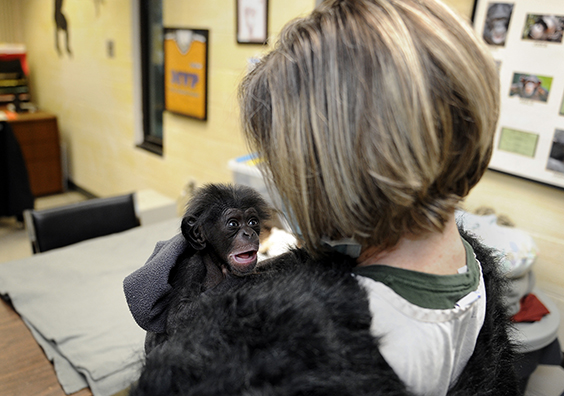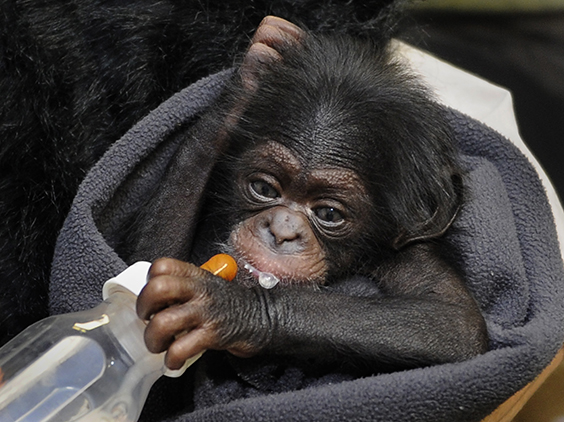A baby female chimpanzee, born at The Maryland Zoo in Baltimore on March 12, has moved to Tampa’s Lowry Park Zoo in search of a surrogate chimp mother after her birth mother was unable to properly care for her.
The infant, named “Keeva,” (pronounced key-va), was born at 2.6 pounds to first-time mother “Carole,” a 27-year-old long-time member of Maryland Zoo’s chimp troop last month. “The birth seemed to be without complication and the baby appeared to be healthy,” stated Mike McClure, general curator at The Maryland Zoo. “However, it soon became apparent that Carole was not adapting to motherhood appropriately and we made the difficult decision to remove and hand-rear the baby while searching for a suitable home with a nurturing surrogate.”
For several weeks, Maryland Zoo staff cared for Keeva 24/7 in a behind-the-scenes area in the Zoo’s Chimpanzee Forest, where she remained in close proximity to the chimp troop. “Even as a tiny infant, it was important to familiarize Keeva with the sights, sounds and even scent of the troop,” continued McClure.
During this same timeframe, the Maryland Zoo’s animal care team worked with the Chimpanzee Species Survival Plan (SSP) of the Association of Zoos and Aquariums (AZA) to identify an adult female chimpanzee who might fill the role of surrogate mother. It was determined that Keeva would be moved to Tampa’s Lowry Park Zoo where she could be matched with a proven surrogate named “Abby.”
“Research has demonstrated the critical importance for young chimpanzees to be raised by members of their own species,” said Dr. Stephen Ross, director of the Lester Fisher Center for the Study & Conservation of Apes at Lincoln Park Zoo and chair of the Chimpanzee Species Survival Plan committee. “Abby, who lives at Tampa’s Lowry Park Zoo, is a proven surrogate, who helped raise other unrelated infants. Ensuring that Keeva is integrated into a chimpanzee group as quickly and safely as possible gives her the best chance for a healthy development.”
Tampa’s Lowry Park Zoo is home to four adult chimpanzees including 32-year-old Abby, a trusted nurturer. While living at Oklahoma City Zoo, Abby raised two orphaned chimps – “Zoe” and “Siri” – from infants to adolescents, and contributed to the care of a third, “Ruben,” who was born in Tampa and moved to Oklahoma when his biological mother passed after his birth.
“We know Abby has the instincts and skills to raise a baby chimp – she has been successful twice before,” noted Lee Ann Rottman, general curator of Tampa’s Lowry Park Zoo, who has worked with great apes for more than 20 years and has successfully hand-reared four infant chimps who are now integrated into chimp troops. “We have every reason to believe that she will raise Keeva as her own, when given the opportunity.”
With Keeva’s welfare as the number one priority, Maryland Zoo team members moved quickly to arrange the transfer, which came courtesy of Animal Rescue Flights (ARF), a network of volunteer pilots who transport dog and cat rescues to new homes around the country. “Initially I wasn’t sure we would be able to find a pilot and plane that had the seating capacity to transport the zoo caregivers along with the chimp,” said Clark Burgard, co-organizer of ARF. “As luck would have it, one of our most experienced pilots was available and volunteered.”
A pilot of nearly four decades, Jeff Luizza stepped forward. “This is one of the most unusual and intriguing cases I’ve flown in 15 years of volunteer rescue and medical transport,” said Luizza, who worked with the Maryland team to expedite the trip. “Flying with ARF and Mr. Luizza was the perfect fit,” noted Carey Ricciardone, mammal collection and conservation manager at The Maryland Zoo, “It allowed us to provide constant care to Keeva along the way, and we are incredibly grateful for his immediate availability.”
Upon arrival in Tampa, Keeva was introduced to a team of animal care specialists who are currently providing round-the-clock care. Human caregivers feed, carry, groom and watch over Keeva from a protected location behind the chimp exhibit where the adult chimps can safely see, hear and smell her.
“From the first moment they laid eyes on her, our chimps have been keenly interested in baby Keeva,” said Angela Belcher, primate animal care manager. “We know from experience that safe social interactions with each member of the chimp troop will be key to her eventual introduction.”
Now weighing a healthy 5 pounds, Keeva is holding her head up on her own, using her long fingers and toes to grasp and hold on, learning vocalizations and facial expressions, and beginning to teethe. By her behavior, Keeva will dictate when she is ready to meet her new family members. At approximately 4 to 6-months of age, she will likely be strong enough to be introduced to Abby, then gradually the other chimps with each providing a different “role” of playmate or aunt/uncle. Infants are completely dependent upon their mothers for at least five years.
The process of integrating a baby chimp into a social group is neither easy nor quick. Chimpanzees live in complex social groups with a strict hierarchical structure. By nature, chimps are smart, aggressive and powerful. DNA studies have shown that the chimpanzee is the closest living genetic relative to humans.
Chimpanzees are classified as endangered on the International Union for the Conservation of Nature’s (IUCN) Red List. One of the greatest threats to the wild chimpanzees is loss of habitat, the African forest, from commercial logging, agriculture and fires. Poaching and disease also put the wild population at risk.











Share this article